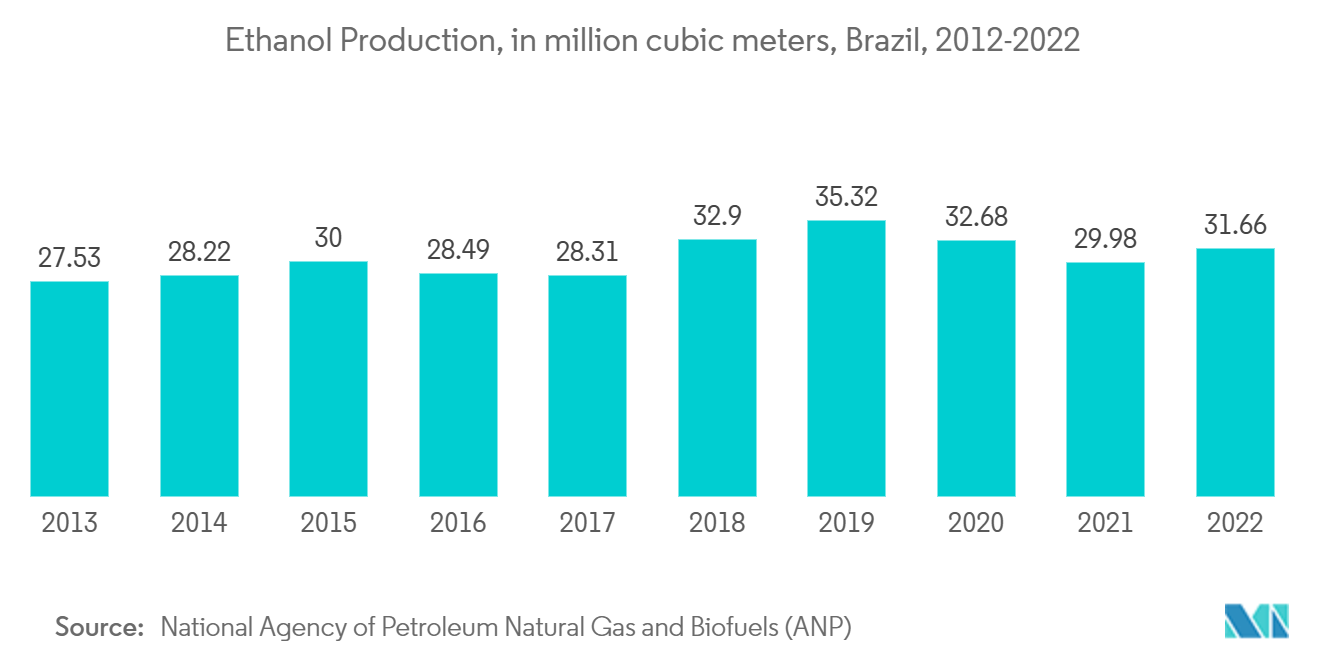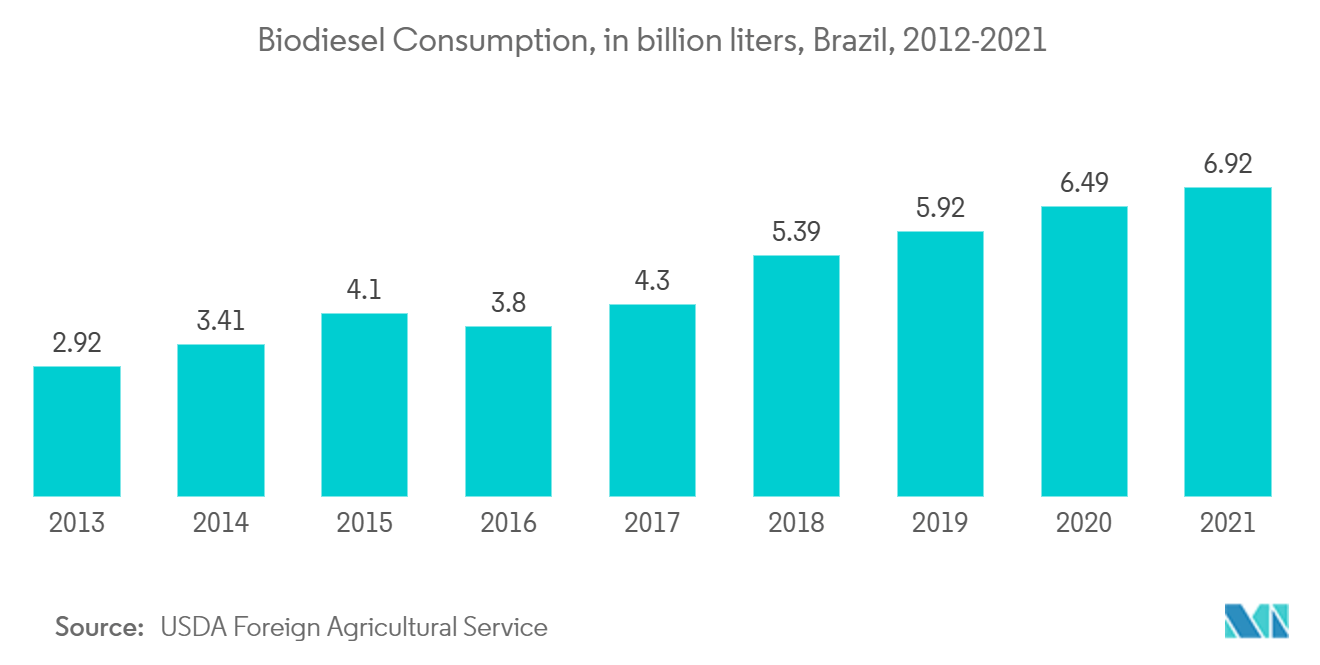Market Trends of Brazil Biofuel Industry
This section covers the major market trends shaping the Brazil Biofuel Market according to our research experts:
Ethanol Likely to Dominate the Market
- Ethanol is a renewable biofuel as it is made from biomass. Most common ethanol production today uses yeast to ferment the starch and sugars in sugarcane, corn, and sugar beets.
- As of 2022, Brazil remained the second-largest leader in ethanol production, following the United States, which is the largest consumer, producer, and exporter of ethanol globally.
- Additionally, as of 2022, according to statistics from the Global Agricultural Information Network, the total consumption of ethanol was estimated at 29.60 billion liters and the total use of ethanol as a fuel in the country was estimated at 27.67 billion liters.
- Similar to biodiesel, ethanol is blended with petrol for usage in transportation, and as of January 2023, the bioethanol mandate stood at 27% and was last updated in 2015. As fuel consumption grows rapidly, such mandates are expected to drive the market during the forecast period.
- The corn-based biofuel in Brazil has increased its share of the country's ethanol mix in recent years, mainly due to increased production capacity concentrated in the country's Mato Grosso and Goiasstates. However, harsh weather conditions and fires seen in 2021/22 have compromised planting activities and damaged sugar cane roots, which is expected to negatively impact production during the next 2/3 years.
- During 2021/22, Brazil produced 115.22 million metric tonnes of corn, up by nearly 32% year-on-year. As corn has grown in popularity in the country, ethanol producers in the country have tried to diversify their supply mix to reduce dependence on sugarcane and climatic conditions. Hence, several corn ethanol plants have been announced in recent years to reduce the dependence on sugarcane.
- For instance, in March 2022, ICM and Agribrasilsigned an agreement to develop a greenfield dry-mill grain ethanol production facility in Mato Grosso, Brazil. The new plant is likely to have a grinding capacity of approximately 1,700 metric tons of corn per day. It is likely to produce over 260 million liters of anhydrous ethanol per year. In addition to ethanol, the plant is expected to produce over 9,000 metric tons of corn distillers oil and over 185,000 metric tons of standard distillers dried grains with solubles (DDGS).
- ATO/Sao Paulo has estimated that the total sucrose (total reducing sugar, TRS) content diverted to sugar and ethanol production for the financial year 2022/23 at 45 and 55%, respectively, unchanged from the financial year 2021/22.
- Consequently, total Brazilian sugarcane-based ethanol production in 2022 is estimated at 27.1 billion liters, an increase of 456 million liters compared to 2021. Additionally, four corn ethanol-based plants are expected to be operational by 2023 and are currently in the construction phase.

Increasing Share and Consumption of Biofuel in Transportation Sector Likely to Drive the Market
- Brazil is among the largest consumers of biodiesel across the globe. Biodiesel, also known as Fatty Acid Methyl Ester (FAME), is produced from animal and plant oils and fats. According to Petroleum, Natural Gas, and Biofuels National Agency (ANP), as of 2022, approximately 15% of biodiesel produced is made from animal fat and around 79% from soybean oil.
- As of 2021, the country has 57 authorized biodiesel production plants, of which 60% are in the Center-West region with a surplus soybean supply.
- The domestic consumption of biodiesel remains highly regulated by the Brazilian government. It is a function of two variables: the mandatory biodiesel blend rate and the overall diesel consumption.
- There are also two primary policies, the National Alcohol Program and the Brazilian Biodiesel Production Use Program (PNPB), that focus on the nation's consumption and production of biofuels. Under the National Alcohol Program, to make the nation less dependent on oil imports, the country is focusing on producing hydrous ethanol dedicated to vehicles driving the consumption of biofuels.
- Similarly, the Brazilian Biodiesel Production and Use Program (PNPB) focuses on the federal implementation of biodiesel production and use. The diesel oil sold to consumers contains a certain percentage of biodiesel imposed by the law, thus, driving the demand and consumption of the biodiesel market in the nation.
- Furthermore, as per the United States Department of Agriculture (USDA) Foreign Agricultural Service, biodiesel consumption has increased rapidly over the years in Brazil from 2.92 billion liters in 2013 to about 6.92 billion liters in 2021.
- In addition, rising technological developments in the automotive industry and the growing production of biodiesel have given rise to the development of biodiesel-fueled engines. Brazil has the world's largest fleet of biofuel-powered cars and heavy vehicles. This is likely to raise the demand for biodiesel-powered heavy vehicles during the forecast period.


